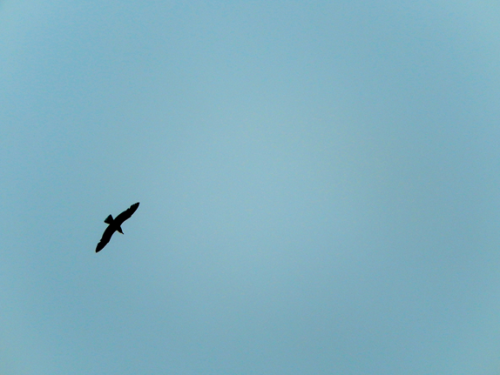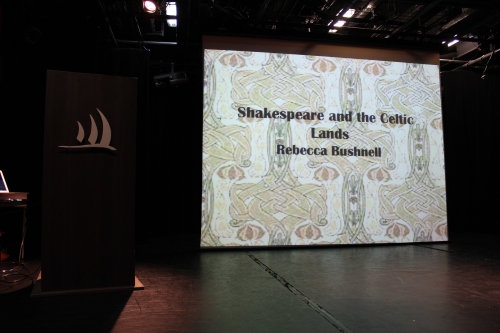Author: David Wallace, Judith Rodin Professor of English
Most of us arrived at Glasgow airport for our Penn Alumni Travel trip across what were once Viking lands. We were then taken by bus to the headquarters of Gohagan, our tour operator, which is based in Glasgow. The company is housed in a beautiful building in the heart of the city:

Some of us chose to rest up in the lounge, and some decided to explore the city center. It was surprising to find a statue of the author Sir Walter Scott close by, since he is most famously associated with Edinburgh; a Glasgow pigeon expresses his opinion:

The nearby Glasgow cathedral contains a chapel known as the Blacadder crypt, after Archbishop Blacadder (1483-1508); a roof boss seemed to cry out “bring out your dead!”

We were transferred to our ship, Le Boréal, and were soon nosing out through evocative islands in beautiful weather:

Le Boréal is the sister ship of L’Austral, on which some of us had travelled before, and accommodates some 400 people (passengers plus crew); it was captained by the handsome and youthful Erwan Le Rouzic, and included a French chef, a French pastry chef, and a French wine steward. The Penn group was quite big at sixteen, but we began getting to know one another at a dinner early in the trip. On 15 June we sailed into the Kyle of Lochalsh, viewing the bridge that now connects Skye to the mainland of Scotland:

On Skye we visited Eilean Donan castle, a fortified castle since the thirteenth century and extensively rebuilt in the 1930s:

The birdlife here is spectacular, and it got ever more interesting as the voyage continued. Some of us stalked this blue heron:

A few hours later we were to see a quite different bird, at Armadale castle:

The presence of this exotic peacock seemed entirely appropriate, since the gardens at Armadale castle were spectacularly lush:


It seemed miraculous that such a far northern Atlantic island could support such lushness, but one of our local guides informed us that in earlier centuries ships had visited Skye filled with ballast of rich soil. Thus Skye was gradually able to produce gardens that might rival those of Florida.
Our next port of call, following another overnight voyage, was Stornoway on the Isle of Lewis. Penn alums John and Jean Donaldson had perhaps felt some special affinity for Skye, stronghold of the Clan Donald; on Lewis Eileen Dooling née MacLeod was able to visit an island where every second person seemed to share her maiden name. Eileen was in fact able to make contact with relatives, who recognized her as one of their own immediately, and while visiting the Callanish Standing Stones I received a phone call from the mother of my Penn colleague, Catriona MacLeod; we met for tea later, in Stornoway. The 3,000 year old stones are spectacular, and it was a pleasure to observe them close up rather than, as at Stonehenge, to be held back by a barrier. Here the Penn banner was unfurled for the first time, by Karen and Gary (Penn Trustee) Rose (left) and Charlton and Christa Carpenter (right):

We then travelled to the Dun Carloway pictish broch, a residence for an extended family built circa 100 BCE.

Jean Donaldson bravely decided to climb to the top of this ancient monument, from the inside:

Following a visit to the Gearranan Blackhouse Village, where traditional crafts such as weaving and thatching were demonstrated, we boarded ship and set sail for the islands collectively known as Orkney. This afforded me the perfect opportunity to present my first lecture to the ship’s company, on Orkneyingasaga, an Old Norse account of the region. This is a strange text, since it contains the usual blood-letting, mayhem, and revenge killings that we might associate with Viking sagas, but halfway through we come across a young nobleman who refuses to fight in a sea battle: he simply lies down in the boat and reads his Psalms. He does become joint-ruler of the region, but is eventually betrayed and captured. Rather than allowing the cycle of violent rivalry to continue he takes the violence upon himself and is martyred; the man who kills and succeeds him, the saga says, was very popular, and a good ruler. Viking morals and mores thus remained mysterious to us as we approached the capital of Orkney, Kirkwall, and viewed its magnificent cathedral, built to honor St Magnus martyr:

While in the cathedral I was looking for something that would support my claim, in the lecture, that Viking culture was able to support or carry over pagan or nature-worshipping motifs even after Christianization. Eventually I spotted a ‘green man’ at the top of a column in the aisle, spewing forth greenery without end:

Our trip to Orkney also included a visit to the Highland Park distillery, the world’s northernmost whiskey makers, and Scapa Flow, home to the British fleet in both world wars and the site of a massive explosion that killed hundreds of young British sailors early in World War II. This explosion, amazingly, was heard by our local guide, as a young girl– she told extraordinary tales of how Italian POWs came to built stronger defences, and how they eventually crafted a beautiful chapel from spare parts and corrugated iron. It was at this point, approaching the chapel, that my camera lost its charge, but I had been able to take a picture of the San Giorgio (St George) erected by the Italians. Many of them have returned to review their handiwork over the years, and are good friends with the islanders.

We also visited Skara Brae, home to successive waves of migrants over some 5,000 years. The Vikings came, adapted what they found, and then eventually left– like these Penn alums, trailing off into the mist by the edge of the Atlantic:

Another night voyage brought us to the port of Lerwick and the Shetland islands, some fifty miles out from Orkney. In driving to the ancient archaeological site of Jarlshof, our driver made a stop at the top of a cliff road. From here we could observe sea birds wheeling in the currents. Most impressive of all were the fulmers, a miniature breed of albatross. They would hang in the breeze, apparently making no effort at all to stay aloft:

Jarlshof, uncovered by a fierce storm during the winter of 1896/7, is an amazing site, with dwellings ranging from late neolithic to Viking longhouses. It also offers friendly refuge for Shetland ponies, and many of us were tempted into selfies:

Later that day we were treated to some first class Shetland fiddling before we set sail for Bergen, Norway. The Penn alums gathered for a cocktail party before dinner, and many tales were exchanged. The most spectacular tale of all was told by Bill Pfeifer (M 68), who had recognized, in another alumni group, a long-lost buddy with whom he had served in a five-man MASH unit. Bill can be seen kneeling, far right. Penn alums have handy skills: Bill gave me the best advice on how to treat an ingrown toenail, and Pamella Dentler (immediately above the Penn crest, V 78) was great on cat care:

In Bergen most of the group visited Troldhaugen, home to the composer Edvard Grieg for 22 years. There was plenty of time to walk the streets, admiring the handsome Hansa houses and contemplating the purchase of reindeer meat:

The building at left in the background here, with the Gothic pointing, is home to Bergen’s new Starbucks. There was just time to take a nautically-framed picture of our handsome ship before heading back out to sea, for Denmark:

It was only on this final leg of the voyage, en route to Copenhagen, that we experienced sea conditions that were anything like challenging. As we headed into the open water between Norway and Denmark, admiring the fjords, there was a swell of 10 metres. This sounds alarming, but the wine glasses in the restaurant did not move at all, even as the sea moved up and down past the window– the stabilizers on this modern ship did an amazing job. We did perhaps eat a little more lightly that night, but we all arrived in Copenhagen in good shape and fine spirits.
Lectures had been offered throughout our voyage, and as ever the attendance was amazingly high: lecturers like myself simply wish that we could bottle this spirit of active engagement, and then sprinkle it over our classrooms. For my final lecture I offered an illustrated review of and commentary on our voyage, and then ended it with a quiz. My threat was that the alums would not be allowed off ship unless they scored at least 60% (the mark set for my American citizenship exam last year). In fact, they collectively remembered everything, however obscure the detail. For example: why do farmers in Shetland use green plastic, rather than black, to wrap the bales of hay pushed out by their combined hravesters? Answer: because experiments have demonstrated that seagulls will attack black bags (associated with promising garbage) but not green ones.
Having scored 100%, then, the alums disembarked and went their separate ways in Copenhagen. Having travelled so far by sea, in favorable conditions, we left in greater awe than ever of the intrepid Vikings. I found this to be a terrific, highly varied groups of alums, and I hope that some of them might join me on another water-bound adventure: travelling down the Zambesi, in February 2015.
Penn Alumni Travel 2015 Full Tour Schedule
David Wallace, FMAA













































